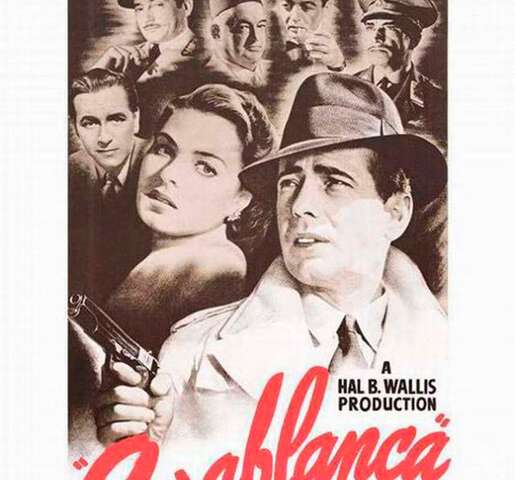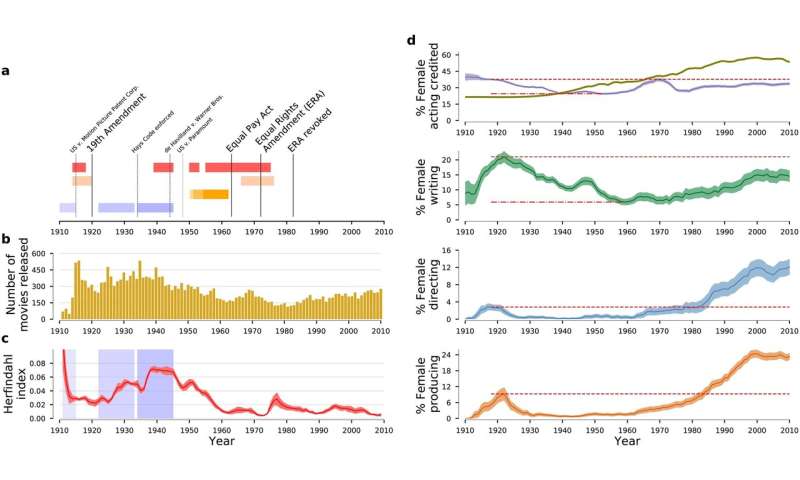Golden age of Hollywood was not so golden for women

The Golden Age of Hollywood is known for its glitz, glamour and classic movies. Northwestern University researchers have peeled back the gilded sheen to reveal an industry tarnished by severe gender inequity.
By analyzing a century of data (1910 to 2010) in the American Film Institute Archive and the Internet Movie Database (IMDb), the researchers found that female representation in the film industry hit an all-time low during the so-called Golden Age. Women representation in the industry still is struggling to recover today.
"A lot of people view this era through rose-colored glasses because Hollywood was producing so many great movies," said Northwestern's Luís Amaral, who led the study. "They argue that types of movies being made—such as Westerns, action and crime—caused the decrease in female representation. But we found the decrease occurred across all genres, including musicals, comedy, fantasy and romance."
The study will be published on April 1 in the journal PLOS ONE.
Amaral is the Erastus Otis Haven Professor of Chemical and Biological Engineering in Northwestern's McCormick School of Engineering.

Consistent findings across all genres and jobs
To conduct the study, Amaral and his team analyzed 26,000 movies produced between 1910 and 2010.
The team looked across all genres—action, adventure, biography, comedy, crime, drama, documentary family, fantasy, film-noir, history, horror, music, musical, mystery, romance, sci-fi, sport, thriller, war, Western and short—to measure how many women worked as actors, screenwriters, directors and producers.
Across all genres and all four job types, the resulting graphs form the exact same "U-shape" pattern. Roles for women increased from 1910 to 1920 and then sharply dropped. Around 1950, the roles steadily increase until 2010.
"In general, we found that the percentage of women compared to men in any role was consistently below 50% for all years from 1912 until now," said study coauthor Murielle Dunand, a former intern in Amaral's laboratory and current student at Massachusetts Institute of Technology.
'Men hire men'
Amaral said his findings reflect what was happening in the film industry.
Before Hollywood's Golden Age, the industry was fueled by independent filmmakers, and women participation was steadily increasing. From 1910 to 1920, according to Amaral's data, women actors comprised roughly 40% of casts. Women wrote 20% of movies, produced 12% and directed 5%. By 1930, acting roles for women were cut in half; producing and directing roles hit close to zero.
Amaral and Dunand said the data suggest that the studio system, which emerged between 1915 and 1920, is most likely responsible for the shift. The industry condensed from a somewhat diverse collection of independent filmmakers scattered across the country to just five studios (Warner Bros., Paramount, MGM, Fox and RKO Pictures), which controlled everything.
"As the studio system falls under the control of a small group of men, women are receiving fewer and fewer jobs," Amaral said. "It looks like male producers hire male directors and male writers. This is association, not causation, but the data is very suggestive."
Women improve conditions for other women
Then, two groundbreaking lawsuits caused the studio system to break apart. First, Oscar-nominated actor Olivia de Havilland, who had an exclusive contract with Warner Bros., sued the studio in 1943 to be freed from her contract and won. In 1948, the U.S. federal government sued Paramount Pictures in an antitrust case. At the time, movie studios owned their own theaters and distributed their own movies. When Paramount lost, studios could no longer exclusively produce, distribute and exhibit their films.
"These legal changes took the power away from a handful of men and gave more people the power to start changing the industry," Amaral said. "There is a connection between increased concentration of power and decreased participation of women."
Among the insights hidden in the data, Amaral found that women producers tend to hire greater proportions of women to work in their films.
"Producers affect the gender of the director," he said. "Women with power in Hollywood are making conditions better for other women.
More information: Amaral LAN, Moreira JAG, Dunand ML, Tejedor Navarro H, Lee HA (2020) Long-term patterns of gender imbalance in an industry without ability or level of interest differences. PLoS ONE 15(4): e0229662. doi.org/10.1371/journal.pone.0229662
Journal information: PLoS ONE
No comments:
Post a Comment